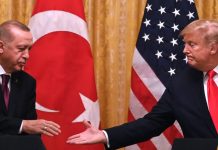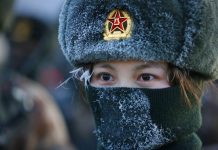OPED Ralph A Cossa
The US Secretary of State, Antony Blinken, recently visited Vietnam, a crucial Southeast Asian trade partner Washington is looking to strengthen ties with to balance China’s growing influence in the region.
War Trophy! World’s Smallest Military-Grade UAV, PD-100 Black Hornet, Seized By Russian Troops In Ukraine Ops
The visit comes as China reportedly refused to let Blinken visit Beijing over concerns that the FBI will release the results of an investigation into the suspected Chinese spy balloon downed in February. Beijing then rejected a request by US Secretary of Defense Austin to meet with his Chinese counterpart along the sidelines of the Shangri-La Dialogue in Singapore.
The United States faces challenges in Southeast Asia in building a formation to counter China and deter any potential action by Beijing against Taiwan. Many countries in the region are reluctant to antagonize China, which is not only a military power but also an important trading partner.
There is a need for both Vietnam and the United States to respond to a rising and increasingly assertive China. This is guided by not only a security concern but economic interests as well.
Vietnam has been dealing with China for thousands of years and fought a border war when the Chinese unsuccessfully tried to teach Vietnam a lesson over Cambodia. China also seized South Vietnamese islands as Saigon fell to the North and continued occupying the Paracels despite Vietnamese claims.
Both China and Vietnam have disputed claims over the entire South China Sea, and the US, like Vietnam, does not recognize as legitimate China’s nine-dashed lines or its claim of sovereignty over the entire region.
Both countries have an interest in ASEAN, and the US looks to greater Vietnamese leadership within ASEAN. Only Vietnam and Indonesia have the size and strength to counter China within ASEAN. Singapore tries to do so via financial measures.
The US continues to pay lip service to ASEAN centrality as a force for stability in Southeast Asia but recognizes that only Vietnam and Indonesia have the ability and courage to stand up to Beijing militarily.
Climate change and rising sea levels are other concerns both countries have in common, but it’s not clear how the two can find common solutions to this problem.
It has been difficult for Vietnam to remain open to cooperation with Washington without upsetting Beijing. This is despite Vietnam being aware of China’s growing assertiveness regarding its disputed military claims in the South China Sea. The diplomatic equation is further complicated by the increasingly close relationship between Beijing and Moscow.
Washington will continue to work towards boosting relations with Vietnam to a “strategic” partnership from one that for the past decade has been called “comprehensive.” This could include increased military cooperation and US weapons supplies. Washington now considers Hanoi as one of America’s most important partners in the region.
The United States is placing great emphasis on “friend-shoring,” and it would be in Vietnam’s interest to be one of the friends. Vietnam is seen as an increasingly important alternative to China as a global workshop since it follows the rule of law, has good logistics, and has a competent workforce.
That presents a win-win situation for Washington and for multinational corporations worried about being too deeply invested in an increasingly unpredictable China.
Many multinationals are looking for alternatives to China, and Vietnam is one of the obvious choices. Taiwanese for years have been investing in Vietnam, and as Taipei tries to reduce its dependence on China’s trade, it has been setting the example for others to follow in expanding investments in Vietnam.
Vietnam is not dependent on China for defense. Its historic reliance on Russia remains a stumbling block, however, since Hanoi is left with few alternatives. It has mostly Russian equipment, which is not performing well in Ukraine, raising questions about its reliability and availability of spare parts, etc., as Russia continues taking significant equipment losses there.
US equipment is expensive, and Hanoi worries about Washington’s willingness to sell, given the Congress’ unpredictability and continuing US human rights concerns, which could result in restricted arms sales. This opens a golden opportunity for France and other European arms dealers to penetrate the Vietnamese arms market.
Good US-Vietnam relations will benefit ASEAN, as does more interdependence and greater US investment in Vietnam and ASEAN in general. While ASEAN does not want to “take sides” in any Sino-US confrontation, most of its members see a strong US presence and engagement commitment (i.e., the old “pivot”) as an important counterbalance to China which they want and need to maintain.
The most familiar refrain one hears throughout ASEAN is, “Don’t brand China as the enemy and ask us to take sides.” However, they then whisper in American ears, “But don’t forget China is the threat, and we want America here and engaged in counterbalancing an increasingly aggressive Beijing.”
While Washington traditionally has not asked ASEAN members to “take sides,” it appears China is increasingly doing so, which may force the issue.
Except for Cambodia and Laos, which have become Chinese client states, most ASEAN countries remain wary of Beijing and would lean toward the US in times of crisis.
What’s missing in ASEAN is any kind of mutual defense pact. Since they have overlapping claims in the South China Sea, an attack on one would not necessarily be seen as an attack on all, allowing Beijing to play divide and conquer.

Both countries can counter China’s growing footprints in the land and seas of the ASEAN region by increasing and improving their bilateral relationship. ASEAN states like Vietnam, who are claimants to South China Sea islands, also need to reach an agreement amongst themselves regarding overlapping and competing claims to prevent Chinese divide and conquer tactics, and this is something the US could facilitate if ASEAN states demonstrated the political courage to move forward in this area.
Multilateral exercises are another effective way of promoting military-to-military cooperation and can be done less controversially when the purpose of the exercise is purely defensive or, better yet, focused on humanitarian assistance and disaster relief.
The ASEAN Defense Ministerial Meeting Plus has provided a useful vehicle for greater military-to-military cooperation and confidence-building measures. Vietnam should be invited to US multilateral ground, air, and naval exercises, including the major RIMPAC exercise held in Hawaiian waters every alternate year.
Given Hanoi’s military capability and its history of success against intruding major powers, Beijing should also worry that if it becomes embroiled in a conflict elsewhere (over Taiwan, for instance), this could open the door for Vietnam to recover the Paracels and other contested territories in the South China Sea.
- Ralph A. Cossa President Emeritus and WSD-Handa Chair in Peace Studies Ralph COSSA has been with the Pacific Forum since 1993, first as Executive Director, then (2001-2018) as President, and now as President Emeritus and WSD-Handa Chair in Peace Studies. He is a member of the ASEAN Regional Forum’s Experts and Eminent Persons Group and a founding member of the Council for Security Cooperation in the Asia Pacific’s Steering Committee.
- Follow EurAsian Times on Google News




